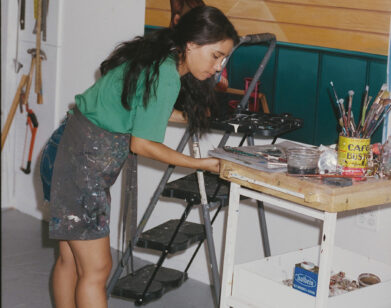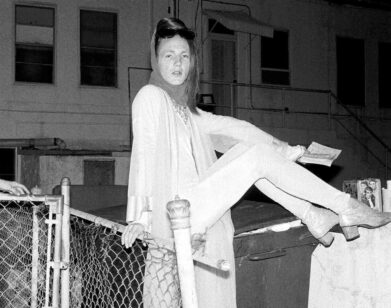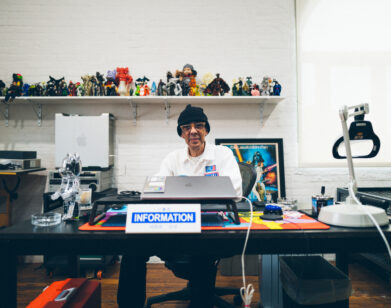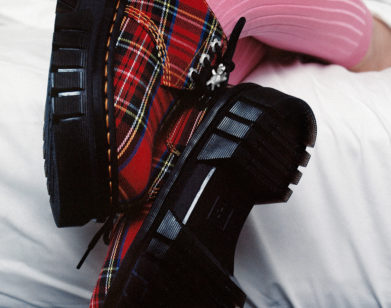John Currin Tells Marc Jacobs What Painting Men Has Taught Him About Himself
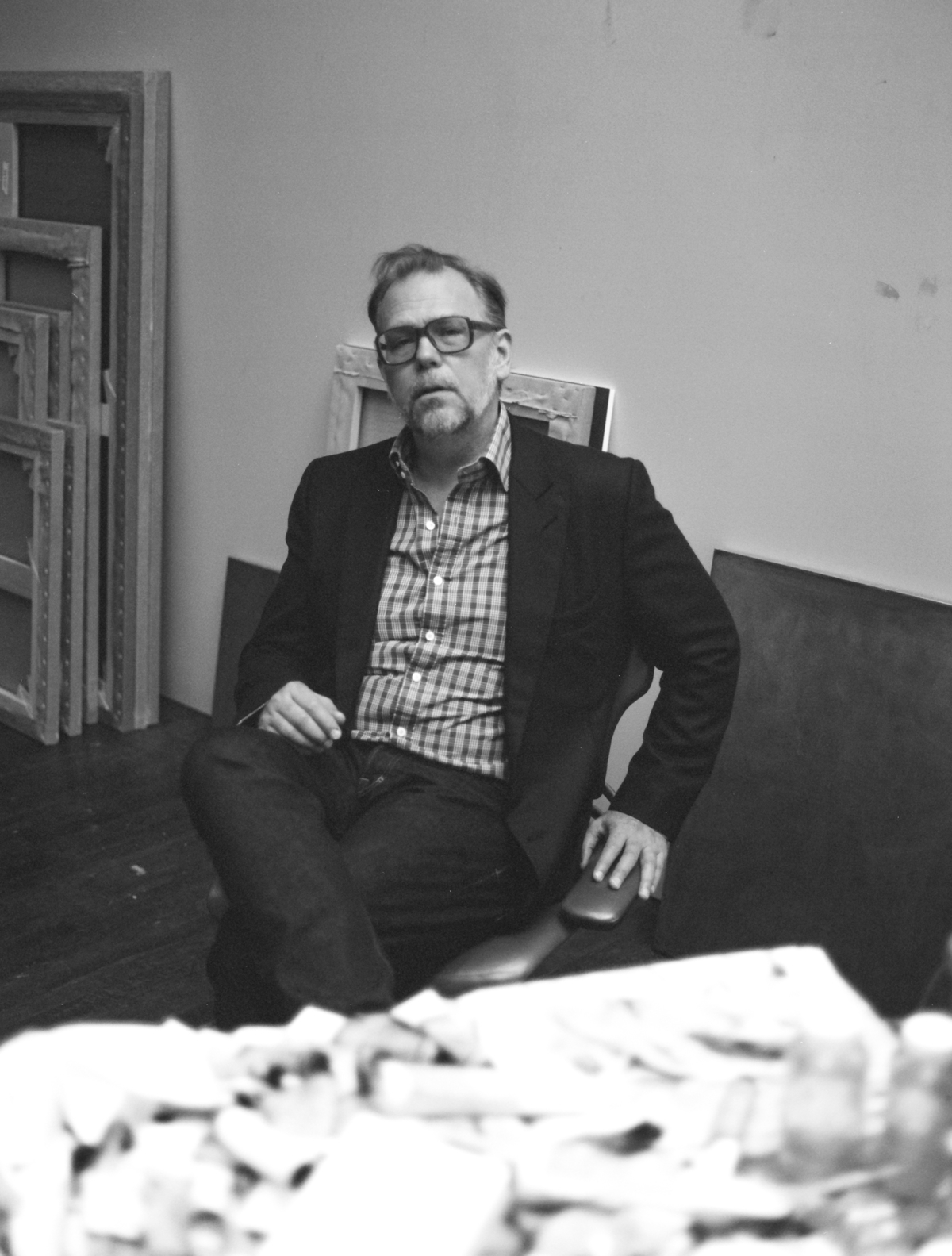
The portrait of a man and his portraits of men.
In the long, sensationalist history of first-strike art reviews, there’s a special place reserved for John Currin’s debut show in New York in 1992. There, the young Colorado-born, Yale-trained artist presented what would become his signature brand of clownish, ribald, highly academic figurative paintings of women. Famously (and not without good feminist intentions), the critic Kim Levin encouraged readers to “boycott this show” in the pages of The Village Voice. Outrage is not a new invention—it has always played a part in the circus of the art world. Over the many decades of Currin’s provocative and groundbreaking career, he has received his fair share of attacks, defenses, reconsiderations, huzzahs, and more attacks for his portrayal of the female form—from the attenuated late-middle-aged dames to his rambunctious, hilariously crass, candy-colored oil paintings based on 1970s Danish porn.
Currin is so identified with his women (red-cheeked, huge-breasted, in disturbing or delightful pulchritudinous poses like modern-day rococo-meets-Mannerism) that it’s easy to forget that the 57-year-old artist also paints men. Thanks to the Dallas Contemporary (and the curator Alison Gingeras), Currin’s study of men, masculinity, and the sometimes sweet, sometimes vicious male form is finally getting its own retrospective this month. Fittingly entitled My Life as a Man, the exhibition covers everything from tender watercolors of adolescent boys filched from Currin’s own high-school yearbook, to the wicked redesign of Playboy ads in his Jackass series, for which the artist changed the faces of all the fawners around the ultimate playboy to one of frank disgust. There are also plenty of paintings of men fondling women’s breasts, men decked in florals or fashion, and even men camping it up with each other. Currin is an equal-opportunity transgressor, letting out the air on the overinflated notion of manhood. He lives in New York, on the North Fork of Long Island, and in Maine with his wife, the artist Rachel Feinstein, and his three children (portraits of his two sons are also included in the show). He was in Maine over the summer when the designer Marc Jacobs called him up to discuss creativity in the age of the #MeToo movement, the difference between painting men and women, and why the muscled male superheroes in comic books weirded him out as a kid.
———
MARC JACOBS: Where in the world are you right now?
JOHN CURRIN: I’m on Mount Desert Island, off of Maine.
JACOBS: How are things in Maine these days?
CURRIN: Just perfect. It’s 69 degrees and I’m in a fast car talking to you.
JACOBS: Are you in your Porsche?
CURRIN: Yeah. I never miss the chance to drive it.
JACOBS: Charly [Defrancesco, Jacobs’s husband] just got a Mercedes truck, and you know, I’ve never learned to drive. I keep telling him that I want to learn to drive just so I can get my midlife-crisis car. Just like John.
CURRIN: You can’t do better than this one, let me tell you.
JACOBS: I went through the catalog for your new show, and it’s all images of men. That’s unusual for you, isn’t it?
CURRIN: Well, men have always been a refuge in my work. I don’t often go there. But every couple of years, I take a break from women and make some men paintings. Either it’s a stand-in for a self-portrait or it’s some kind of rumination—I don’t know. Eighty percent of the great paintings in the world are bearded guys or muscle men fighting or something like that, so after I do all these Venuses, it becomes a temptation to do a few Marses.
JACOBS: Does the decision to do this show now have anything to do with what’s happening in the culture at large?
CURRIN: It is a fraught moment for men in general and maybe for me in particular. It’s been on my mind with my paintings, and I didn’t know what to make of it. I suppose I feel some inhibitions as a result of it.
JACOBS: You mean that you feel inhibitions about painting women?
CURRIN: About my imagery, yeah, but I always have. I’ve felt those inhibitions before the #MeToo movement. But right now, when the entire culture is paying attention to the same thing, I feel like I’m painting in public or something.
JACOBS: I’ve always seen your work as your celebration of and adoration for women.
CURRIN: The meanings and feelings of my work are never entirely under my control. There’s definitely sexism, misogyny, and all kinds of bad stuff that comes up in the work. But right now, when there are so many people paying attention to what you should and shouldn’t do—
JACOBS: The judges.
CURRIN: Yeah. I know it’s high time for some of this. But it makes me a little inhibited, and any good artist needs to get over that.
JACOBS: In terms of creative work, at each step we’re always asking ourselves, “Can we do this? Does this feel okay? Should we stay away from this?” And even if, in the end, we go back to making the choices we make, it’s definitely an energy-consuming, thought-provoking derailment for a while. I don’t know if the process of art is different, but I personally feel a certain responsibility to listen to those conversations before just barreling ahead.
CURRIN: I guess so, but I don’t think it’s helpful in terms of making art. You can keep yourself out of trouble, but I don’t think it’ll help you make anything better. You can’t make mistakes if mistakes now carry such a high price. And so you end up retreating into your personal life. And speaking of midlife crises and sports cars and stuff, you retreat into yourself no matter what at a certain age, because you don’t have the stake in culture that young people do. I think that’s just a fact of getting older. In a way, my engagement is weirdly less high-stakes, even though I can get in more trouble now. It’s more that I don’t care as much now as I did when I was a complete nobody who cared a lot. Which is, I guess, another way of saying, “Oh, you’ve just become a boring conservative.” But I think it’s more that I’m focused on my family and on my ability to keep making work. That’s really what it is. I never wanted to sound like one of those ’70s rockers in the ’80s talking about keeping the faith, but here we are.
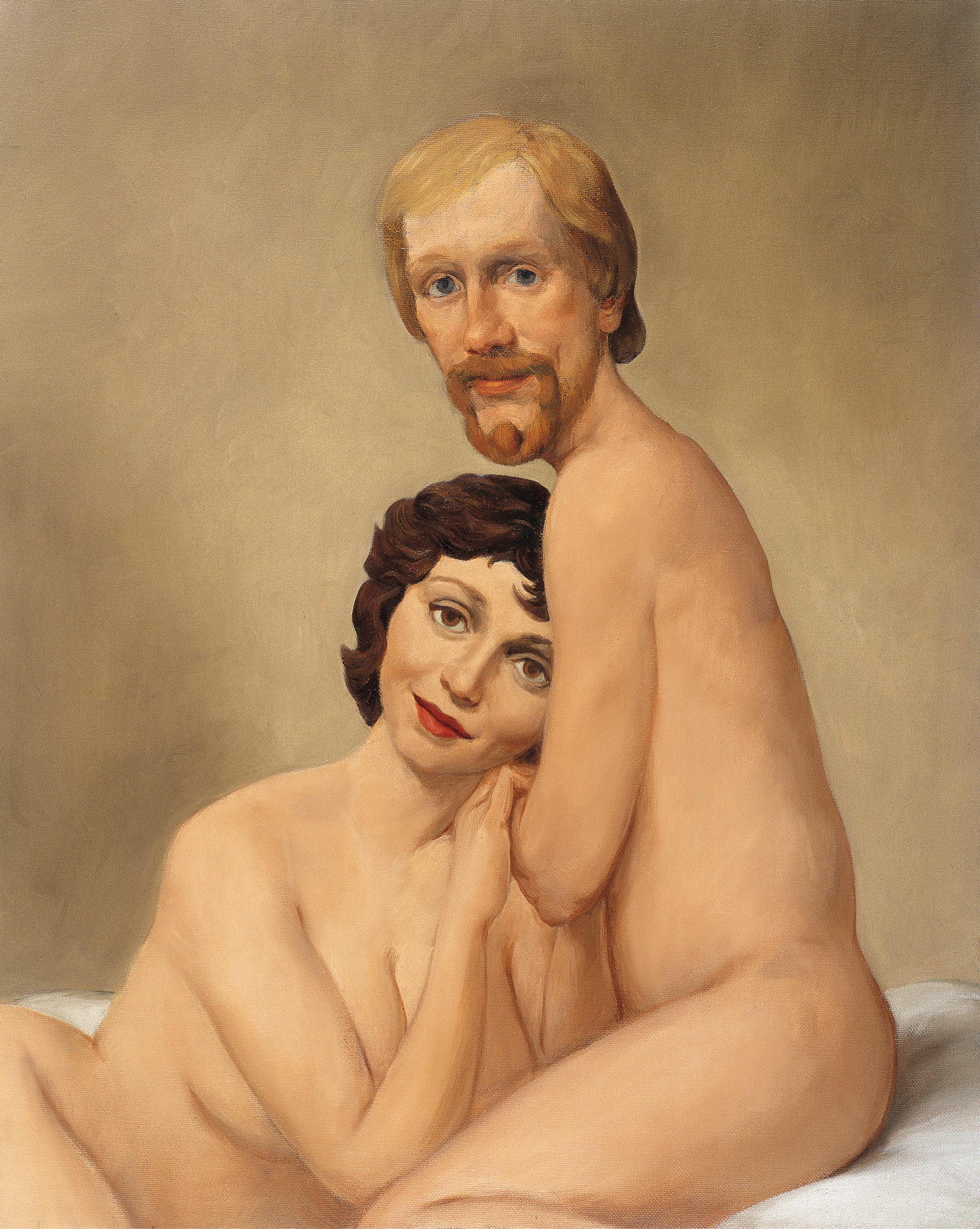
Couple in Bed, 1993.
JACOBS: I think it’s a natural evolution for anybody as they get older—all the things I hoped I’d never say, I’ve said recently.
CURRIN: The funny thing is, that’s the man I’m painting. I’m representing the asshole or the guy who lost the plot. The image of men I give voice to in my work is a clown-like parallelism of not worrying about stepping on people’s toes, that whole Clint Eastwood “go it alone” type thing, which itself is a parody of sensitivity. And that’s what I do when I’m working. I follow my feelings and then I resolve or interpret them. It’s not like I start with a motive. It’s the other way around. I start with feelings and blunder my way through an idea. Which is why, when you feel the Eye of Sauron on you from the start, it’s inhibiting. I can’t imagine what it’s like in your world, where you get in trouble for doing braids. [In 2016, Jacobs was accused of cultural appropriation for sending models down the runway in hairstyles that referenced dreadlocks.] How can you do anything if the trip wires are everywhere?
JACOBS: I speak to friends in different creative professions, from Sofia [Coppola] to Lana [Wachowski]. In each of our ways, we feel that pressure. The question is, do you trust your instincts? Do you make your work and make your mistakes, which seem like part of the process?
CURRIN: The mistakes that you should really regret are the ones that make things ugly, not the things that offend people. If you make a bad painting or a bad dress, that’s a mistake you should regret. And even those mistakes can later turn to gold. You make something embarrassing and terrible, but the reason you did it lingers, and without making mistakes, you’ll never make anything good. So I don’t think it’s helpful to get in the habit of avoiding mistakes. It’s not really a great moment in our culture right now. In a way, painting men, I know no one’s going to get upset with that.
JACOBS: Do you feel that you’re less criticized when you do men? As you said, there is still something exaggerated and clownish about your portrayal of them, just as when you do women.
CURRIN: Well, I’ve always liked stereotypes as a vessel. I hope this doesn’t sound like bullshit, but stereotypes appeal to me because they’re so dumb and because the meaning they convey is already known. It’s nothing new. But then there are the unrelated feelings and associations and meanings that can inhabit those stereotypes. Do you remember when we watched The Bitter Tears of Petra von Kant [1972] together? Those characters are extreme vessels, but they’re presented as normal. Everybody is gay and dressed up and dancing and crying and weird shit is happening, and time is moving in a weird way. But I like the idea that stereotype becomes an internal, almost classical template of representation, no matter how flamboyant or strange or otherworldly it appears. It might come off as mean-spirited or whatever, but I can’t express myself without that rigid structure.
JACOBS: This might be a basic question, but do you paint women using live models?
CURRIN: Yes, although less now. I’ve found myself less interested in it. I’m more interested in making it up. I went through a period of about ten years where I felt like I shouldn’t paint if I didn’t have a model in front of me, but eventually it started hampering me a bit. Also, I want to be alone more. If you’re painting from a model, you’re not alone. I don’t much like that.
JACOBS: Your male paintings aren’t from models?
CURRIN: No, not unless it’s me in the mirror, or something like that. I don’t really like to paint men. Early on, I painted women from magazines and put beards on them because I was so put off by the idea of painting men.
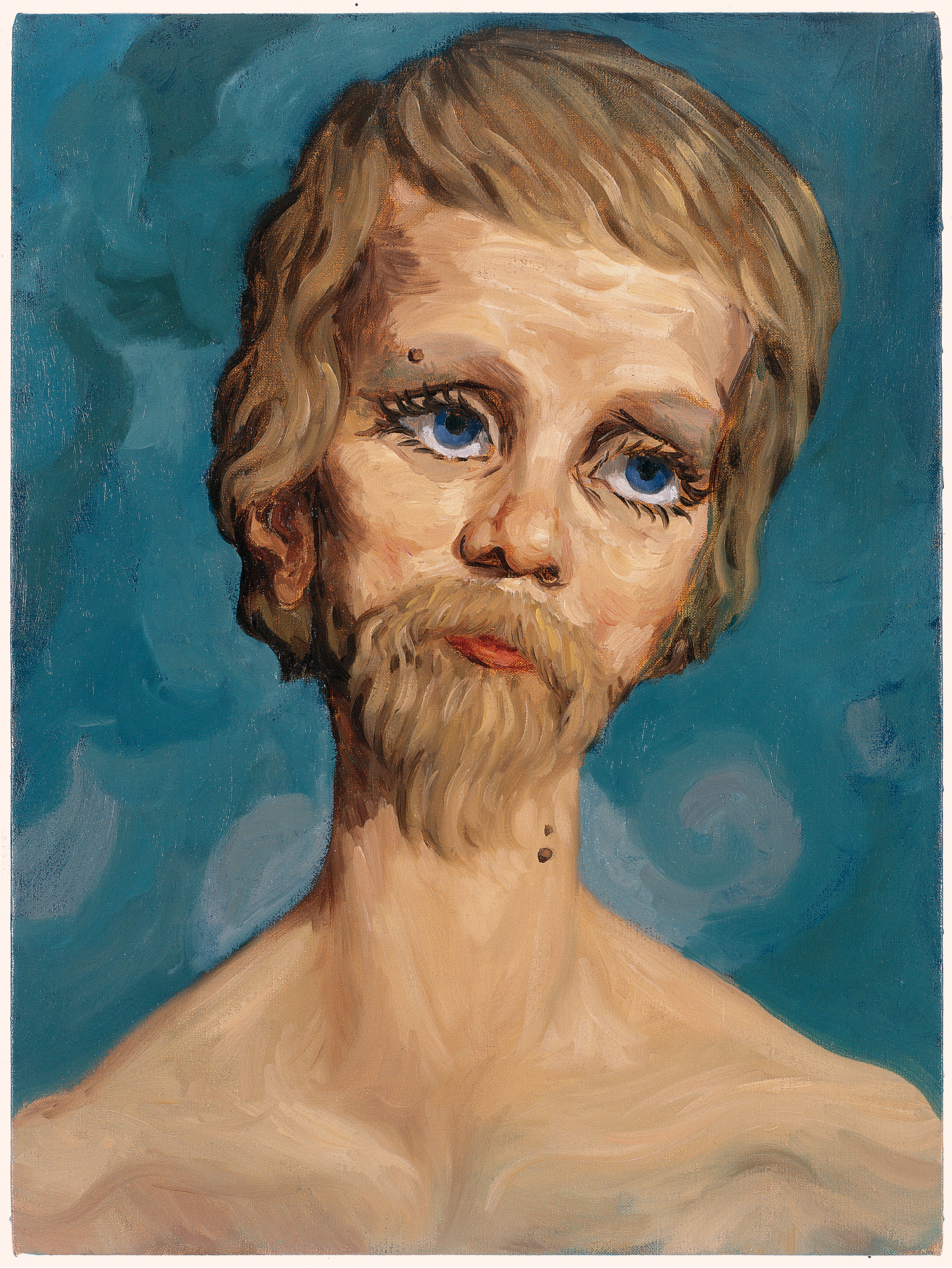
Innocent, Loser, Prophet, 1995.
JACOBS: Tell me about the Jackass series that’s in the show. I’ve always loved those ones. They crack me up.
CURRIN: Actually, that came from the guy who introduced me to Rachel. He called me up out of the blue—I really didn’t know him—and he said he was a good friend of Rachel’s, and it turned out he told Rachel he was a good friend of mine. He really didn’t know either of us, but that’s how I met Rachel, and I fell in love with her and I asked her to marry me right away. This guy was like an angel. Anyway, he sent over 20 boxes of Playboy to my studio one day. They just showed up. There were from 1968 to 1980. They were literally golden age—the centerfolds were brown and orange, like food-photography colors. Playboy would have these inside ads for its ideal demographic about buying stereos and how they like cologne and how rich they are—that kind of stuff. The title was, “What Sort of Man Reads Playboy?”—meaning that the sort of man who reads Playboy buys $700 worth of stereo equipment. Then they had these amazing photographs of this man shopping for the kids, and the woman who’s with him is completely in awe, and then the other women 15 feet away are also all looking at him, just thinking he’s great. I thought it would be funny to make all the women hate him. So I just turned him into the opposite. I called him “The Jackass” because my dad used to call people that. But it could also be a simple metaphor for what we were talking about before of making your art and not worrying about what people say about you. This guy maintains his serenity and confidence in the face of all this hatred and disapproval. That’s really all it was. I just took gloss and changed the women’s faces. And sometimes the faces of the animals and other men, so everyone hates him.
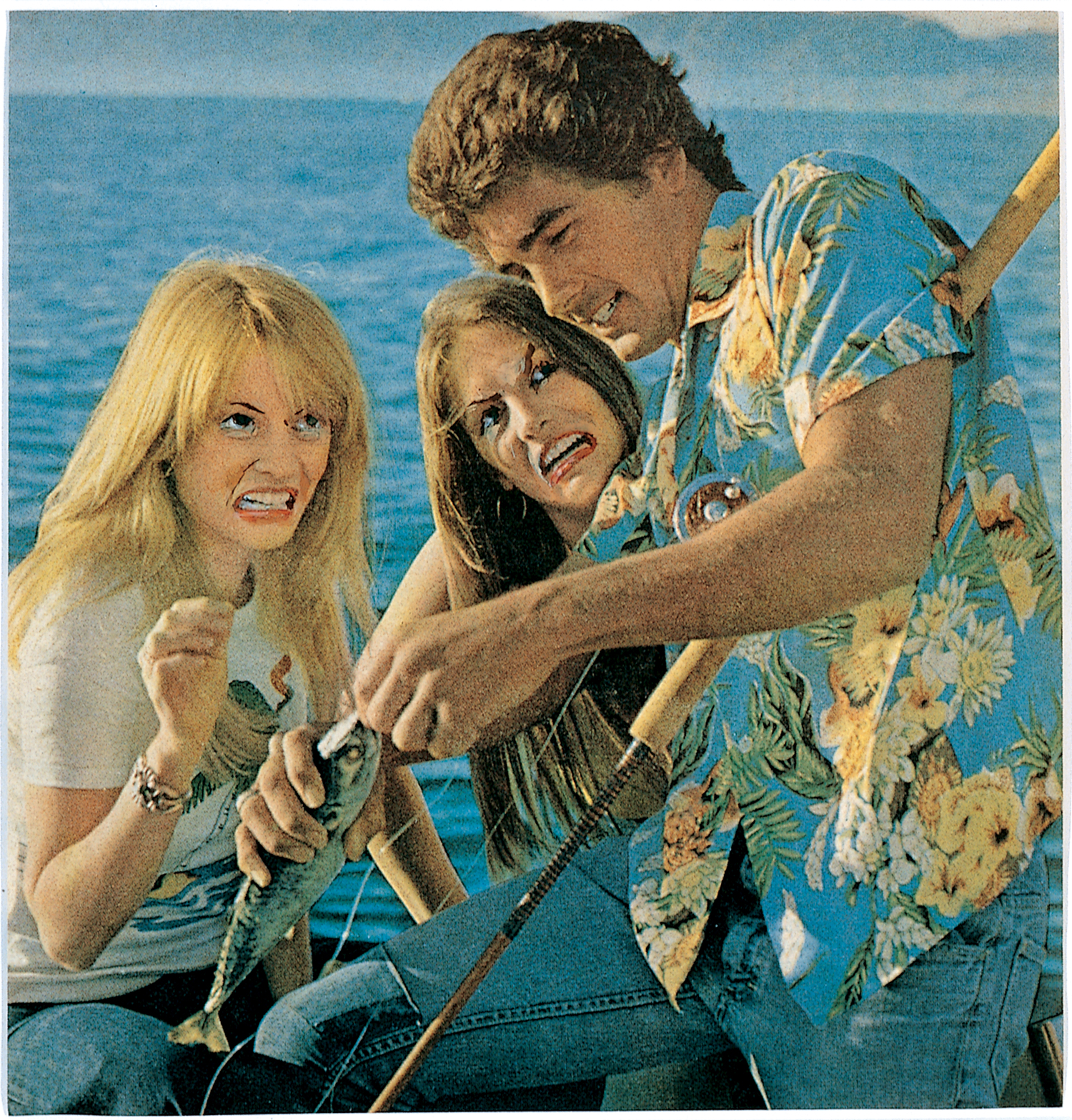
The Jackass (Guy Fishing with Two Babes), 1997.
JACOBS: They’re hilarious.
CURRIN: This guy is so cool. He shops for his own vegetables. He takes a plane to Alaska. He does brunch.
JACOBS: He’s just the best. Stylish, cool, athletic, caring, sensitive, and well rounded—he’s the shit.
CURRIN: It was thrilling to make these ads more dramatic by making the women scream and yell, and cry in completely outlandish situations. I wanted to try to get some real emotion in there. No matter how ironic or cynical I’m being, I can’t help when I’m actually doing the work to try to feel it. I think of it more like a rococo painting, where the situation in its entirety is ridiculous, but things are really happening—there’s color and emotion. It wouldn’t be effective if there weren’t real emotions at play. The other reason for them was that at this time, in the late ’90s, I was getting more of an urge to make compositionally complex paintings. I was still in my mode of isolating a woman, or her body, and having this magnifying glass in the sun burning a hole in her with concentration. I wanted to do something more [Nicolas] Poussin, more chaotic. I ended up with the pornographic paintings.
JACOBS: I was just about to ask you about the pornographic paintings. You mentioned that you don’t like to paint men, and yet these paintings are filled with men in the act of sex.
CURRIN: Well, weirdly, I found that painting a bulging penis was easier than painting the guy’s face. I’d paint a penis as if it were a vase on the table. The guy could be a cartoon. His penis has to be convincing and real and exciting and spectacular, but the face just has to be the right number of eyes and a mouth. That kind of solved my lack of empathy for men. Mostly, though, it satisfied my urge to make a really complex painting with stuff going every which way—not just sex organs, but people’s arms and legs. I was trying to figure out how to make something as clunky and old-fashioned as oil painting as exciting as advertisements.
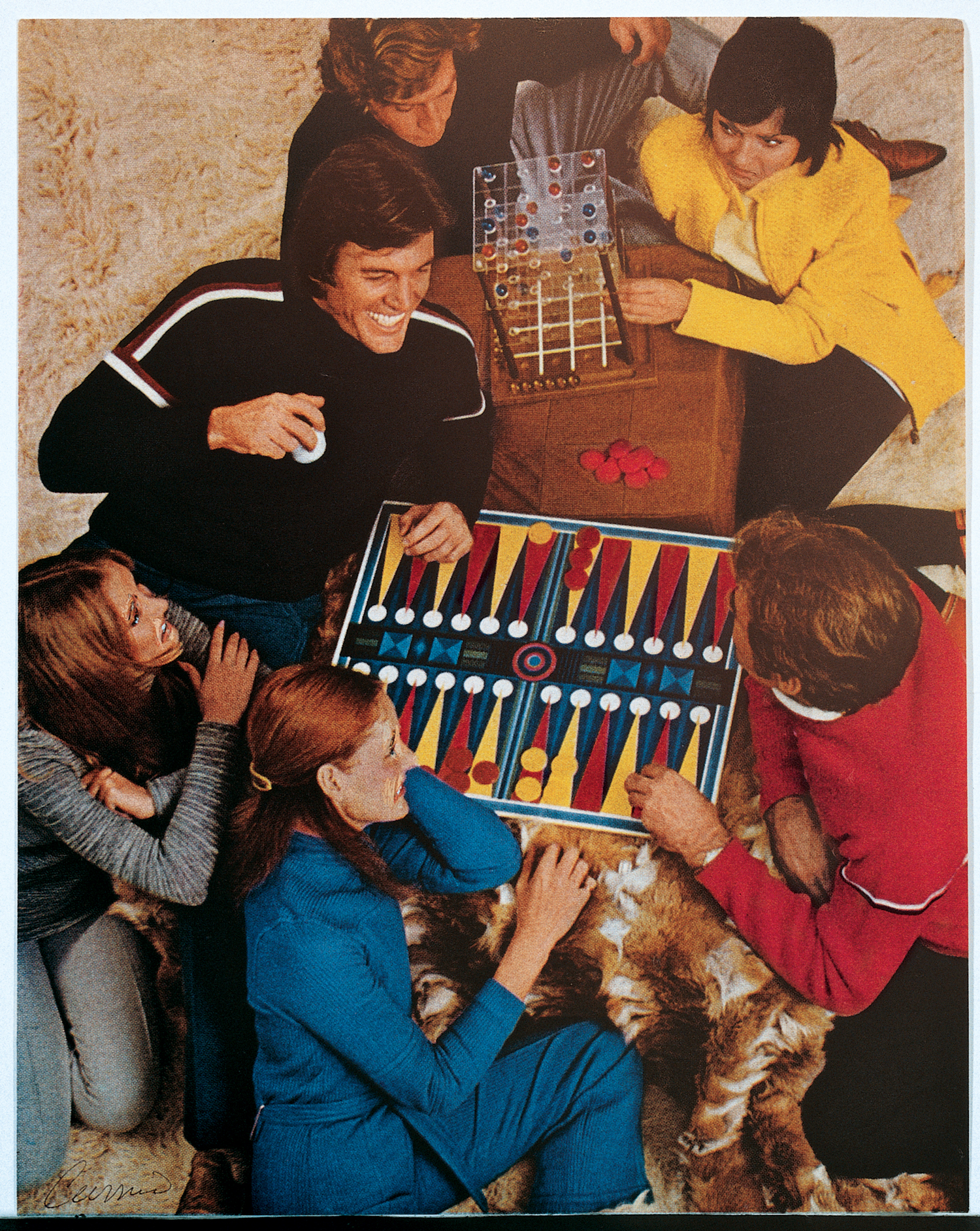
The Jackass (Backgammon), 1997.
JACOBS: Does your own heterosexuality come into play when you’re painting men?
CURRIN: I think so. I think it’s harder for me to caress men’s bodies with a brush. I actually think in the olden days, sex roles might have been a little less rigidly stratified. And so I think physical contact between men was less sexualized. Straight men back in the glory days of painting had a healthier or more comfortable attitude toward physical contact with men than they do today—or rather than I do. I have a rather unhealthy or uptight attitude toward men’s bodies. For instance, I always found comic books weird—the muscles and tight clothes, it always bothered me. My favorite artist as a teenager was Frank Frazetta, who did Conan the Barbarian. But I always found it made me a little uncomfortable, all the loving attention to the musculature of the men in a way that doesn’t bother me in Michelangelo, or any of the supposedly gay artists, where it just seems normal and the way you should look at a man’s body. In the 20th century, it became much different, and it probably has a lot to do with the way men were shown in movies and on TV. I rented all these TV shows like Love Boat and Bonanza to look for faces. And what occurred to me was how it’s almost constantly men. You’re basically looking at men when you’re watching a movie or a TV show.
JACOBS: I think that’s a huge part of the conversation today. There’s this patriarchy that has existed in Hollywood, in making movies and TV shows and writing books. It’s all guys.
CURRIN: That’s also what I liked about Petra von Kant. There are no men. They talk about men, but you don’t look at men.
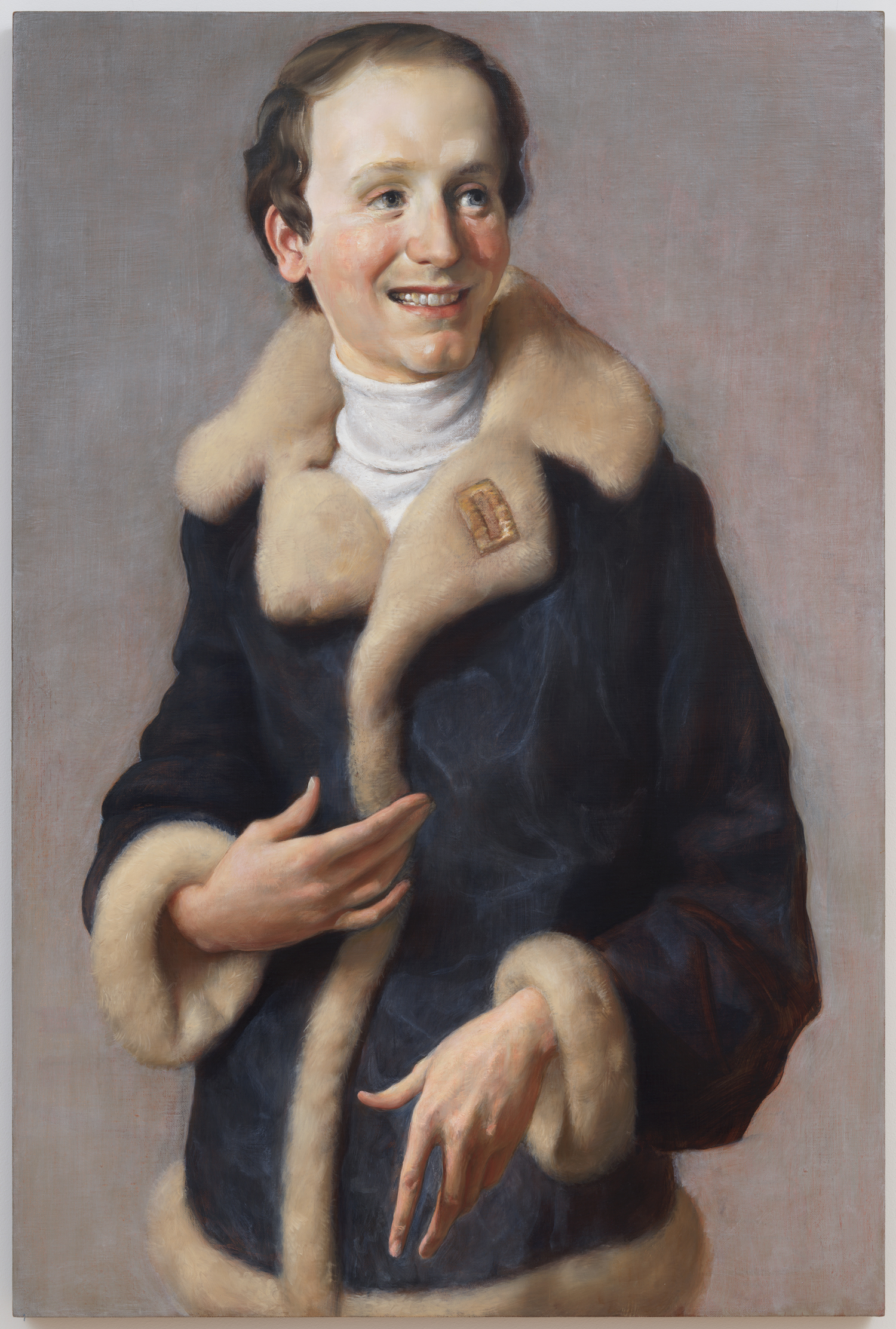
The Producer, 2002.
JACOBS: You’ve painted your own sons, Hollis and Francis, as well as your daughter, Flora, and your wife. They are very different paintings than the ones we’ve talked about. How does that personal relationship change the way you paint your subjects?
CURRIN: With Rachel and the kids, a lot of the defenses and inhibitions I have when I’m painting faces go away. The reason I like to paint Rachel is the idealizing that happens. I’m not even conscious of it. I do change things about her face, but I’m not aware of it. And that’s the closest I get to a natural approach to painting. Because honestly when you think of the anachronism it is in the society—politically, sexually, historically, and physically—to do oil painting, the cartoon of confidence that it takes to be a male figurative painter is always on my mind. And I guess that falls away a bit with my children and my wife.
JACOBS: What’s your relationship with the world in general right now? You and Rachel have never exactly been social hermits. You were out and about. But you also have your place in Maine and in Orient on the North Fork.
CURRIN: Any time I have outside of working is taken up by the kids. That’s the truth. I used to have these leisurely ten-hour days where I would waste four hours and then work for six hours, and now I just don’t have the time to waste. Some of the dreaminess of life is gone. It used to be that after the solitude of the studio, I would love to go out and see people and be at a party. I had no idea before I had kids how much time and energy it takes. And it matters more than anything else. I’m not an easygoing person, so just to maintain my blood pressure I’ve got to keep life as simple as I can.
JACOBS: Do you also think your relationship to New York has changed as a creative person?
CURRIN: I’ve always loved New York, especially when I started being able to afford it. It was wonderful, especially being young with Rachel in New York. I went through a lot to try to make a house for my family and myself that would be something special and different in New York. But I have to say, I don’t think my kids like it very much. I feel some significant guilt for raising them in New York City, thereby denying them some of the psychological benefits of being outside of it. I wonder if it’s made them more capable or less capable. I’m not sure.
JACOBS: I loved being brought up in the city.
CURRIN: I know what it’s like to be money poor in New York City, and that was in the New York City of 25 years ago. It was hard then. I imagine it’s much harder now. I think that part of the problem is that people leave at the first sock to the face that they get; they leave and go to Los Angeles. I don’t know whether it’s just that you get punched harder now as a young person, but I know I got hit in the face a lot, figuratively speaking. And literally, too.
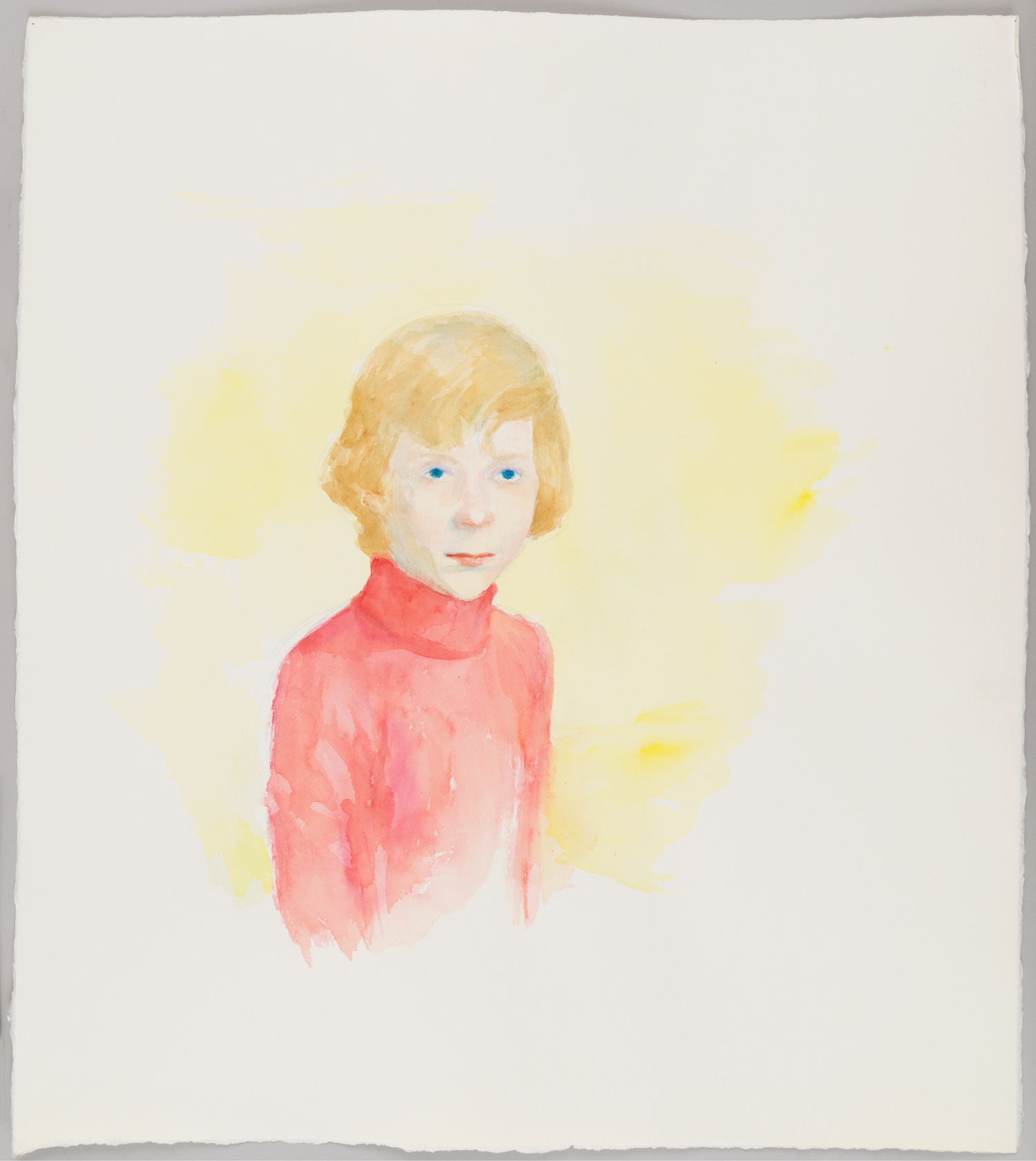
(Untitled), 1990.
My Life as a Man is on view from September 15th to December 22nd at the Dallas Contemporary.

